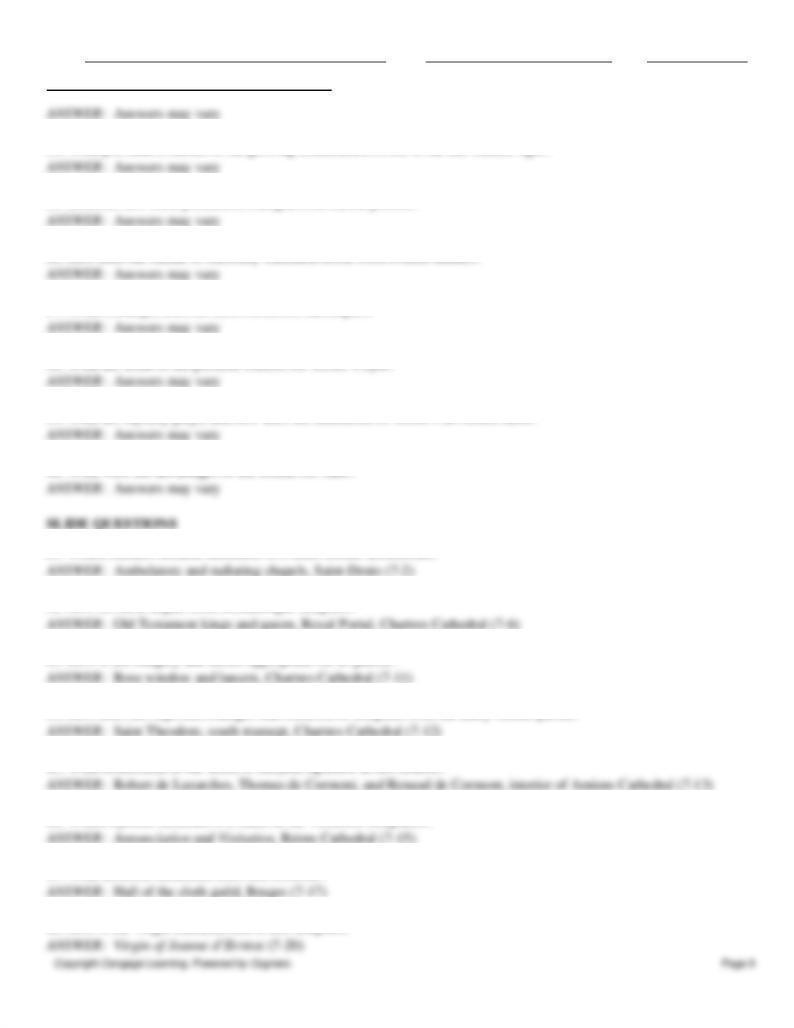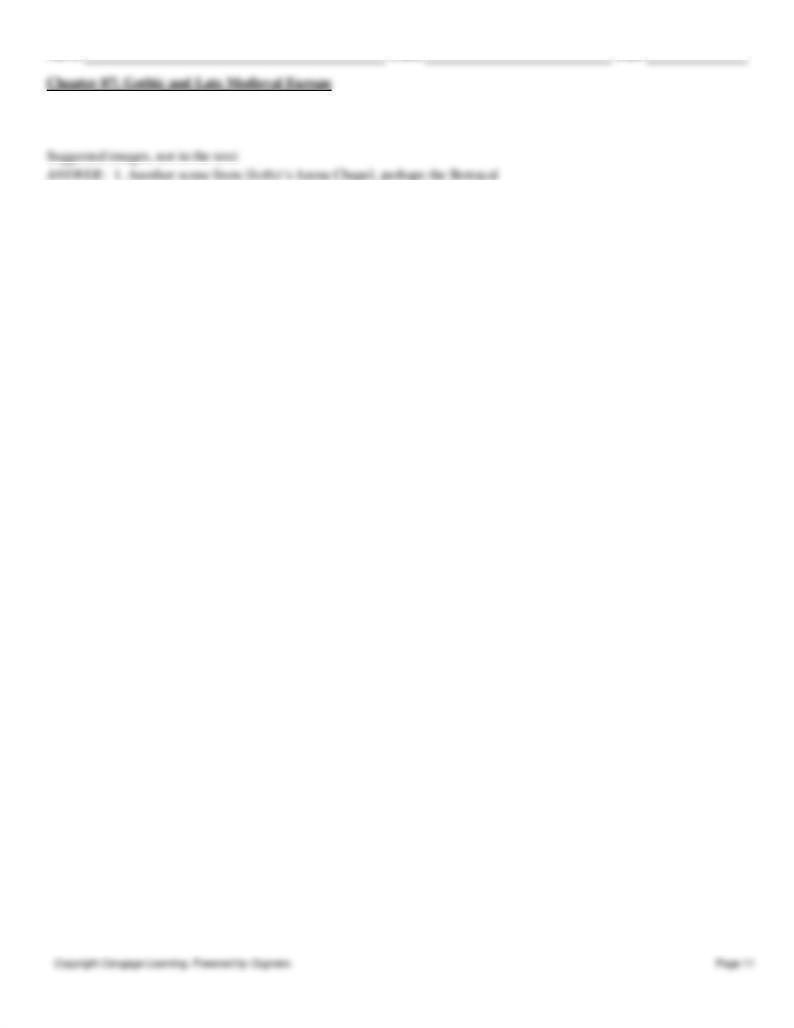
Name:
Class:
Date:
Chapter 07: Gothic and Late Medieval Europe
Multiple Choice
1. Indicating its innovative nature, the name given to the French Gothic style by its contemporaries was the _____.
a.
opus modernum
b.
Roman style
c.
pilgrimage style
d.
lux nova
2. The Cathedral of _____ was significant because it was the site of the coronation of French kings.
a.
Notre-Dame
b.
Reims
c.
Naumburg
d.
Amiens
3. The 16th-century Italian artist and writer _____ used Gothic as a term of ridicule.
a.
Cimabue
b.
Dante
c.
Giorgio Vasari
d.
Saint Francis
4. In comparison to Romanesque sculptures, those created in the Gothic period are _____.
a.
tied to their architectural structure
b.
more abstract
c.
reminiscent of the Byzantine style
d.
more fully detached from the walls
5. Fan vaulting was most common in which of the following?
a.
Germany
b.
France
c.
Italy
d.
England
6. The Gothic style first appeared in _____.
a.
Lombardy
b.
Canterbury
c.
Burgundy
d.
the Île de France

Name:
Class:
Date:
7. The Perpendicular style was popular in _____.
a.
England
b.
Germany
c.
France
d.
Italy
8. Which of the following is considered a masterpiece of the Rayonnant style?
a.
Reims Cathedral
b.
Sainte-Chapelle
c.
Saint-Denis
d.
Chartres Cathedral
9. The Arena Chapel, which contains frescoes by Giotto di Bondone, was commissioned by _____.
a.
the Sienese civic government
b.
the guild of linen merchants
c.
Giotto
d.
Enrico Scrovegni
10. In the Gothic period, intellectual and spiritual life shifted from the monasteries to the _____.
a.
cities
b.
palaces
c.
universities
d.
convents
11. The _____ of Chartres takes its name from its jamb statues depicting kings and queens.
a.
south transept
b.
Royal Portal
c.
rose window
d.
oratory
12. Scholars consider the post-1194 Chartres Cathedral to be the first _____ building.
a.
English
b.
secular
c.
High Gothic
d.
Rayonnant
13. During the High Gothic, the gallery tribune was replaced by a band of arcades called the _____.
a.
crenellation

Name:
Class:
Date:
Chapter 07: Gothic and Late Medieval Europe
b.
gallery of the kings
c.
lancet
d.
triforium
14. The technique of _____ produced a greater range of colored glass for artists to use.
a.
flashing
b.
bar tracery
c.
enamel
d.
leading
15. Amiens Cathedral largely followed the plan and elevation of Chartres Cathedral but has _____.
a.
lower vaults
b.
more slender proportions
c.
more aisles
d.
a double transept
16. Abbot Suger is credited with introducing Gothic forms at _____.
a.
Saint-Sernin
b.
Saint-Denis
c.
Sainte-Chapelle
d.
Notre-Dame, Paris
17. Which of the following was characteristic of the work of Simone Martini?
a.
Use of elegant flowing contour
b.
Emphasis on drama
c.
Bold modeling of the figures
d.
Emphasis on delineation of three-dimensional space
18. At Reims Cathedral _____ replaced the stone sculptures normally found in the tympanum.
a.
solid bar tracery
b.
mosaic
c.
stained glass
d.
murals
19. The bell tower of the Florence Cathedral is unlike its northern European counterparts because it _____.
a.
reaches high into the heavens
b.
is self-sufficient
c.
employs spiral staircases

Name:
Class:
Date:
Chapter 07: Gothic and Late Medieval Europe
d.
was made by a well-known architect, not an anonymous craftsman
20. The _____ style of the High Gothic was preferred by the court of Saint Louis.
a.
Perpindicular
b.
Fan vault
c.
Rayonnant
d.
Mannerist
21. The _____ was an architectural symbol of the importance of artisans and merchants.
a.
Arena Chapel
b.
Maestà
c.
Reims Cathedral
d.
Hall of the cloth guild in Bruges
22. During the Gothic era, _____ was the leading city for book illumination.
a.
Paris
b.
Naumburg
c.
Florence
d.
Venice
23. Gothic manuscripts known as _____ paired Old Testament and New Testament scenes and provided an explanation of
their meaning.
a.
the Divine Comedy
b.
Moralized Bibles
c.
Gospel books
d.
In Praise of Scribes
24. In the image of God as the Creator of the World, God is depicted creating the universe using _____.
a.
the Holy Spirit
b.
magic
c.
geometric principles
d.
religious leaders
25. In English Gothic architecture, an emphasis on _____ was not adopted from the French Gothic style.
a.
colored stone
b.
sculpted decoration
c.
vaults
d.
height

Name:
Class:
Date:
Chapter 07: Gothic and Late Medieval Europe
26. Which region was famous for its metalworkers and enamelers?
a.
Meuse River
b.
Burgundy
c.
Tuscany
d.
England
27. At Naumburg Cathedral the decorative program commissioned by _____ included sculptures of the church’s
benefactors.
a.
Holy Roman emperor Frederick II
b.
Dietrich II of Wettin
c.
Nicholas of Verdun
d.
Philip von Heinsberg
28. The sculptures of Ekkehard and Uta by the Naumburg Master appear to be _____.
a.
Byzantine
b.
French
c.
portraits
d.
Romanesque
29. The Röttgen Pietà reflects the growing interest in _____.
a.
landscape
b.
the apostles
c.
Jesus’s divine nature
d.
Jesus’s suffering
30. Which new type of church furnishing might the artist Nicola Pisano have invented?
a.
Pulpit
b.
Altarpiece
c.
Reliquary
d.
Crucifix
31. The _____ style of art dominated Italian painting throughout the Middle Ages.
a.
illusionistic
b.
Byzantine
c.
French
d.
Pompeian

Name:
Class:
Date:
32. _____ is regarded as the first Renaissance painter.
a.
Enrico Scrovegni
b.
Cimabue
c.
Giotto di Bondone
d.
Simone Martini
33. (Figure 7-31)
a.
Siena
b.
Pisa
c.
Rome
d.
Padua
34. (Figure 7-16)
a.
Perpendicular
b.
Classical
c.
Rayonnant
d.
Early Gothic
35. (Figure 7-1)
a.
Chartres
b.
Paris
c.
Amiens
d.
Reims
36. (Figure 7-20)
a.
Virgin of Paris
b.
Virgin of Salisbury
c.
Virgin of Jeanne d’Evreux
d.
Virgin of Röttgen
37. (Figure 7-13)
a.
Notre Dame, Paris
b.
Amiens Cathedral
c.
Cologne Cathedral
d.
Chartres Cathedral

Name:
Class:
Date:
38. (Figure 7–2)
a.
Saint-Denis
b.
Sainte Chapelle
c.
Notre Dame, Paris
d.
Chartres Cathedral
39. (Figure 7-12)
a.
Saint Theodore
b.
Saint George
c.
Saint Peter
d.
Saint Martin
40. (Figure 7-15)
a.
Annunciation and Visitation
b.
Annunciation and Transfiguration
c.
Transfiguration and Lamentation
d.
Visitation and Lamentation
41. (Figure 7-37)
a.
Sainte-Chapelle
b.
Florence Cathedral
c.
Orvieto Cathedral
d.
Siena Cathedral
42. (Figure 7-29)
a.
Giotto
b.
Cimabue
c.
Duccio
d.
Ambrogio Lorenzetti
43. (Figure 7-30)
a.
Duccio
b.
Cimabue
c.
Ambrogio Lorenzetti
d.
Giotto di Bondone
44. (Figure 7-35)
a.
Cimabue

Name:
Class:
Date:
Chapter 07: Gothic and Late Medieval Europe
b.
Duccio
c.
Simone Martini and Lippo Memmi
d.
Nicola Pisano
45. (Figure 7-38)
a.
Florence Cathedral
b.
Cologne Cathedral
c.
Orvieto Cathedral
d.
Milan Cathedral
46. (Figure 7-36)
a.
Florence
b.
Siena
c.
Rome
d.
Paris
47. (Figure 7-33)
a.
Cimabue
b.
Giotto di Bondone
c.
Simone Martini
d.
Duccio
48. What prompted the rebuilding of Saint-Denis, and why was Saint-Denis significant?
49. Although destroyed in the French Revolution, the decoration of the facade of Saint-Denis influenced later Gothic
churches. What was the subject matter portrayed there and later on Chartres’s Royal Portal?
50. Describe Mary’s role at Chartres. What demonstrates her growing importance?
51. How do stained-glass windows differ from other forms of painting?
52. How did theologians from the Gothic age describe the significance of stained-glass windows?
53. How did the stone frames of stained-glass windows evolve?

Name:
Class:
Date:
Chapter 07: Gothic and Late Medieval Europe
54. What provided evidence of the growing urbanization of life in the late Middle Ages?
55. Describe how book production changed from earlier periods.
56. How does the facade of Salisbury Cathedral differ from French facades?
57. Which concepts does the term humanism encompass?
58. What are some of the possible sources for Giotto’s style?
59. What are mystery plays, and how does the naturalism of Giotto’s art reflect them?
60. What were the advantages of the Gothic rib vault?
61. Which features became hallmarks of French Gothic architecture?
62. How do these depart from Romanesque sculpture?
63. How is the imagery and motifs appropriate for its patron?
64. How does this represent changes that occurred in sculpture from the Early Gothic period?
65. What contributed to the sense of buoyant lightness at this church?
66. Which stylistic influence is evident in the Visitation sculptures?
67. What different influences does this combine?
68. How is the Virgin characterized in this sculpture?

Name:
Class:
Date:
69. How does this reflect the heritage of the Byzantine icon?
70. Architectural sculpture continued to be significant in the Gothic age. To what extent does Gothic sculpture borrow or
depart from the Romanesque? Were there any changes from the Early to the High Gothic period?
71. Chartres Cathedral is considered the first High Gothic church. Which features designate it as High Gothic? Please
consider new features in the plan, structure, and nave elevation. What overall visual qualities were achieved?
72. The abundance of stained-glass windows is a hallmark of Gothic architecture. Why did theologians think that its
presence was so important? How was stained glass created, and what visual effects did it impart?
73. The Gothic style immediately became popular in other parts of Europe. Identify which regions embraced the Gothic
style? Which aspects of the French style did they borrow? How did they adapt the Gothic to their own aesthetic
preferences?
74. Although English Gothic churches, such as Salisbury Cathedral, borrowed the primary features of the Gothic style,
there were also significant differences. Identify these differences considering the exterior and interior of Salisbury. How
did English Gothic develop differently than French Gothic?
75. In the late medieval period, several different trends existed in sculpture and painting. Citing examples, identify the
different trends. What inspired these different stylistic manners? How did artists adopt or depart from their sources?
76. Describe Giotto di Bondone’s contributions to naturalism. Please consider his representation of figures, setting, and
the lighting of images.
77. Siena was an important center in Italy in the late Middle Ages. Who is regarded as the most important painter?
Describe the artists who followed, as well as their important contributions.
78. Discuss the contribution of classical antiquity to Gothic art and architecture. Use examples to support your essay.
79. What was the significance of the Meuse River region for sculpture in the Gothic period? Citing examples, describe the
outstanding qualities of German sculpture.

Name:
Class:
Date:
80. Attribute the images on the screen to a culture and give an approximate date. Give the reasons for your attributions,
using complete sentences and referring to specific works discussed in class.
2. Another scene from Duccio’s Maestà, perhaps the Entry into Jerusalem
3. Another scene from Nicola Pisano’s Pisa pulpit, perhaps the Adoration of the Magi
4. French Early Gothic interior with quadripartite elevation, such as Senlis
5. English perpendicular Gothic interior with fan vaults, such as Kings College Chapel, Cambridge